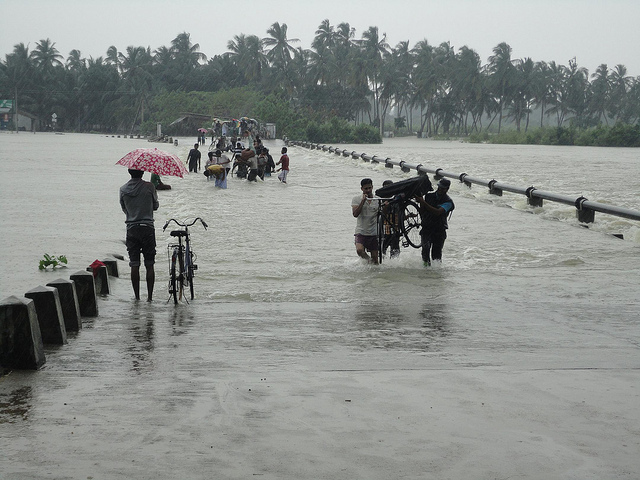
Climate change, floods and landslides
The shifting and unpredictable weather pattern is the most talked about topic today, especially in Sri Lanka. The Meteorology Department, National Building Research Organisation and several other associated divisions engage in constructive discourse regarding this concern. Extreme heat, heavy rain, landslides and lightning are among the main issues faced by the people. Who or what is the cause for all these changes? It is a well-known fact that the humans itself are the cause for all these transformations. However, corrective measures to address this crisis have being taken by most of the developed countries which had realized the gravity of the problem. They have understood that humans are the cause for Al Neno, depletion of Ozone.
Though pink clouds and smog were witnessed in most of the capital cities in the west during the past, they are clearly absent now. However, many non-western countries including India, China and Sri Lanka now face a severe challenge due to the constant climatic changes.
Pollution in Colombo was to be measured and informed to the public. This no longer happens. Maybe the equipment too is not functioning. When it rains at night, a clear blue sky is seen the following morning as all polluted clouds get washed away. Recently, while I was walking along a passageway, it started to rain suddenly. As usual, everyone ran for shelter. While I too briskly marched to find some cover, I saw a vendor, who was wrapping up the fruits he had brought to sell, with a polythene sheet. Though it was a normal scenario, I thought of approaching him to inquire as to why he covered the fruits that would otherwise be exposed to the rain. My thinking was that the dust collected in the outer layers of the fruits would wash away with rain water, and hence, the fruit would later be edible.
When I questioned the vendor about his action, he then said, “The fruit would get spoiled if the acid rain touches them.”
The point is that a vendor knows the aftermath of pollution which many of us are unaware of. It is high time that legislators are made to comprehend the ground situation by walking among the public instead of moving about in luxury vehicles with tinted shutters. The western world, however, took corrective measures to combat these concerns. They took steps towards sustainable development by planting trees, controlling the emission of carbon dioxide/monoxide emitted from vehicles and minimizing the use of ozone depleting devices, as well as introducing strict laws.
In the interim, vehicle manufacturers were compelled to move into fuel efficient and electric vehicles, thereby reducing the use of fossil fuel resulting a drop in fuel consumption and prices.
China and India have gone to the extent of banning the use of vehicles on certain days to reduce pollution.
Meanwhile, Sri Lanka is yet to introduce clean air public transport, but continues to import diesel busses and trucks. Educating the public is most the important thing in the transference. In USA, most of the parks and other recreation areas have stopped permitting private vehicles to enter as a measure towards creating a green environment. In this country, belching vehicles and busses are allowed even to Yala and other animal habitats.
What have we done in Sri Lanka? The so called Paradise! Introducing a mechanism to control vehicle emission was a step in the right direction. 90% of the vehicles on the street are clear. The balance 10% is still not clean due to corruption in the system, and the non-dedication of the public. Let us be happy that there are honest citizens in the country with respect to pollution control of exhaust. Some time back, expensive machinery was imported to randomly check moving vehicles. What has happened and where has the equipment gone now?
Prominent personalities initiated several tree planting campaigns. But what has happened and where have these trees been grown? The forest cover is reducing daily. Only trees planted by President Premadasa are seen in some parts of the country. Since independence, the country is merely a ‘Bottle of Soda’ when the cap is opened.
Fortunately, the UDA/RDA started to plant trees along the newly developed roads, but the CMC has failed to act as a curator to maintain them. They are not been fertilized to maintain growth as some leaves are yellow or the trees are stunted. Yahapalanaya is required here. Destruction of forests is taking place to a great extent. Legislators and citizens have to only pass Timber Saw Mills to witness the majestic trees that have been felled. It is easy to notice the difference from the trunk of the downed trees if they are from Cultivated Forests or from Natural Forests.
For the law to be implemented and enforced effectively, the legislator, executive and judiciary have to collaborate. Sri Lanka Police, Department of Forrest Conservation and other related authorities have to only visit the Saw Mills and take action against them instead of checking vehicles transporting timber logs which leads to corruption.
There is technology available to determine the life span of a tree. Of course the Judicial System of the country has to be accelerated as action taken by the authorities will drag on for years and years due to the lethargy and inefficiency of the Judiciary, resulting in the timber being lost to the country by natural causes due to rotting and no production of whatever the timber was supposed to produce.
We talk of rainfall and landslides. If the Meteorology Department takes data, the average rainfall for the country has not varied much other than for a minimal +/- year to year. Floods and landslides have augmented. What is the reason? Rainfall on land is not retained as there is less shrubs, trees and roots to reduce the flow of water downstream resulting in more water flowing from high elevation to low elevation prior to ground absorption, and finally, on to rivers thereby raising the level of water in rivers.
Landslides too are caused by rain water finding its way down at a faster rate dropping ground water absorption due to the absence of trees, resulting in the surrounding earth being washed away. During the days Ceylon was administered by the British, no deforestation was allowed over a height of 4,000 Feet if I remember correct, although they grew tea at high elevation. Sri Lanka forgot all these environment friendly laws of the British and continued on a destructive path influenced by politicians, mostly for political and personal benefit. 30% forest cover since independence has now reduced to 19%. The result of the destruction of forest cover on mountains, wild life, fauna and flora, life and limb of innocent citizens of the country who work in estates and lives in villages at high elevation is affected. It is the general public that has to bear the cost of rebuilding and relocating these innocent people, but lives lost cannot be replaced.
If the President, Prime Minister, Legislators and those responsible take a tour by Helicopter or a Low Flying Air Craft over the hill country or use GPS technology, they will be able to note the bare mountain tops especially in Nuwara Eliya, Diyatalawa. There are many Golf Courses that have popped up at high elevation on state land. Fox Hill was a thick jungle a few years ago, it is now a race track with no trees in sight in the surrounding. Knuckles range has many areas cleared, Sinharaja has many vacant arias which was thick jungle a few years ago. All this destruction is for reasons known only by those in power. Sad but true! –
(Source :13 May 2016 -Daily Mirror (Sri Lanka) http://www.dailymirror.lk/109414/Climate-change-floods-and-landslides#sthash.j7rfBNoP.dpuf)
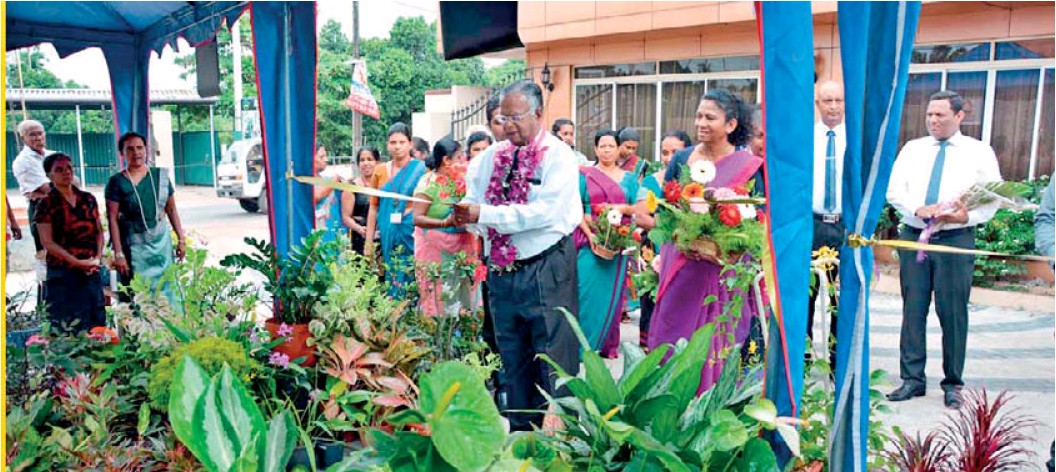
HDFC Bank conducts Entrepreneurship Development Programme for SMES
Aspecial awareness programme was conducted by the Piliyandala branch of the HDFC Bank for the small and medium-scale entrepreneurs who are engaged in Horticulture. This was organized with the collaboration of the Department of Agriculture, Western area and was held at Rochelle Gardens, Kottawa recently. There were about 140 participants from Horticulture Micro societies from the Piliyandala, Homagama and Nugegoda areas.
The necessary awareness on the financial literacy, ornamental plant cultivation and decorations with flowers and plants was given to the participants. The session on the financial Literacy was conducted by Mr.keerthi Dunuthilake, the Senior Assistant Director of the Regional Development Department of the Central Bank of Sri Lanka. The presentation on ornamental plant cultivation was done by Mr. S.h.kahingala , Agricultural consultant of the Department of Agriculture in the Galle District.
At this event, the Chairman of the HDFC Bank MR.R.J.DE Silva and the CEO/GM Mr.upali Hettiarachchi handed over the savings pass books to the beneficiaries who had availed themselves of loans under the SME scheme of the bank. Mrs.s.wickramathilake , Assistant Director of the Department of Agriculture – Western Province, Mrs.ramya Gunawardena, the Regional Manager Western Region of HDFC and Amal Kiriella, the Piliyandala Branch Manager and the other staff members were also present at the occasion.
The members of the Micro loan societies appreciated the efforts by the HDFC Bank to organice
(Source :12 May 2016 -Daily Mirror (Sri Lanka) http://dailymirrorepaper.newspaperdirect.com/epaper/viewer.aspx)
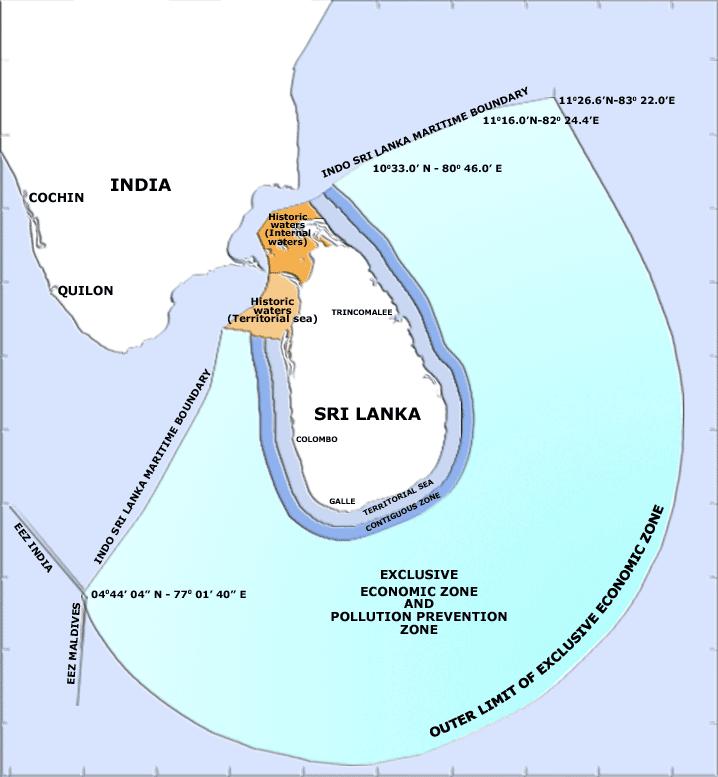
Sri Lanka to declare fish habitats as protected zones
Sri Lanka intends to better protect fish habitats around the island by declaring them as protected zones in order to safeguard the resources for the future, said Udaya Senevirathne, Secretary to the Ministry of Mahaweli Development and Environment.
Government policy is to ensure the sustainability of marine resources for economic development and conservation, he told the 8th GEF Biennial International Waters Conference that began in Sri Lanka on Monday.
“We hope to protect fishing areas around the island to practice sustainable fisheries, and declare some fish habitats that contain fisheries resources for the future as protected zones.”
Senevirathne said Sri Lanka is party to the Bay of Bengal Large Marine Ecosystem Project.
“The Bay of Bengal is an important source of food and income for Sri Lanka.”
(Source: Date 11-05-2016 Economy Next http://www.economynext.com/Sri_Lanka _to_declare_fish_habitats_as_protected_zones-3-4945-9.html)
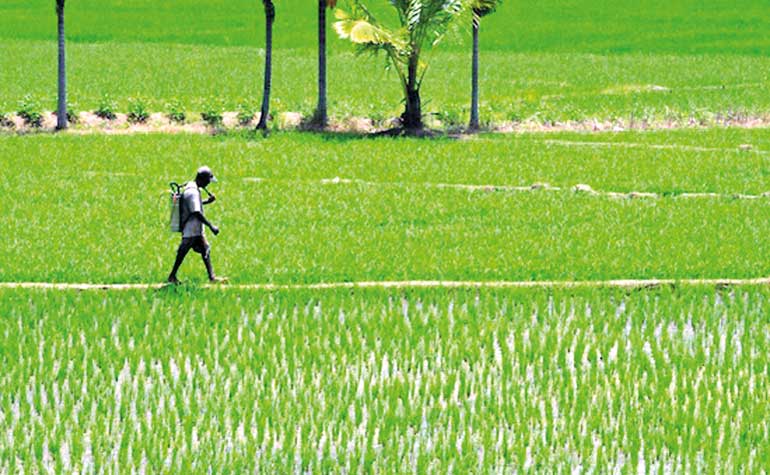
As the climate shifts, tradition threatens Sri Lanka’s rice harvest

Thomson Reuters Foundation: In mid-April, at the same time of year as their families have done for generations, Sri Lanka’s paddy farmers started cultivating their rice fields.
But this year, that may be too late.
President Maithripala Sirisena has warned Sri Lanka’ farmers that they may run out of water before their crops are ready to harvest. Devotion to tradition – in particular, planting spring crops after a traditional New Year’s holiday in mid-April – could now prove devastating, he said.
But many farmers are so far not convinced that old schedules need to change to match new climate patterns – a problem many countries around the world face as they try to adjust to changing weather patterns.
Ranjith Sumanadasa, 50, a paddy farmer from Rajanganaya region in Sri Lanka’s north-central province, has been cultivating his rice for close to four decades based on traditional timetables.
“I learned from my father that after the March harvest we will celebrate Avurudu, and then prepare the fields around a week or two later, then the water comes,” he said. “There is no other way I know of.”
In early April, at a public rally in his native Polonnaruwa District, Sirisena explained how he had tried to convince Sri Lanka’s rice farmers to start cultivating a few weeks earlier than normal, to take advantage of recent rains that had filled some of the country’s reservoirs almost to capacity.
Sticking to the traditional timetable, he said, would mean losing much of that needed water to evaporation.
“I instructed the Water Management Committee to release water for paddy farmers as soon as possible,” Sirisena said on 2 April. “But the paddy farmers remain unmoved. They want to start the cultivation after the (traditional) New Year.”
Rains during the last weeks of March filled some reservoirs in the north and central parts of the country. As authorities released water from hydropower reservoirs to generate electricity, they also sent some to the smaller irrigation reservoirs to water rice fields, in the hopes the farmers would take advantage and use it right away.
But farmers instead waited over two weeks before using it, Sirisena said. With the island experiencing temperatures between 2 degrees Celsius and 4 degrees Celsius above average, according to the Meteorological Department, some of that water was lost.
“Because of the hot temperatures we are losing hundreds of cubic meters of water daily due to evaporation,” the president told the gathering in Polonnaruwa District. “You have to reconsider getting into the fields before the end of the month,” he pleaded.
Harvests evaporating?
When Sirisena spoke to the country’s paddy farmers in early April, the main irrigation tanks in the north central and central provinces were at around 80% capacity. But by the third week of April – when farmers wanted to start watering their crops – the levels had dropped by 20%, officials said.
Water management officials estimate that close to 300 million litres of water were evaporating daily across Sri Lanka. That could mean trouble for the paddy farms, which cover over 10% of the country’s land area.
“You will have to bear responsibility if there is a water shortage mid-season,” the president told farmers.
To make matters worse, Sir Lanka has experienced below-average rains across most of the island through April, according to the Met Department. May is also predicted to be unseasonably dry.
In 2014, a similar spell of dry weather hit Sri Lanka’s rice farmers, resulting in a harvest of 3.3 million tons, 17% less than the year before. Although Sri Lanka’s farmers are aware of the shift in the country’s climate patterns – and the potentially dire consequences – many refuse to change the way they farm.
Sri Lanka’s paddy farmers have long followed a cultivation schedule based on two monsoon seasons: Maha, between November and March, and Yala, between April and October. Based on that timetable, paddy farmers begin to prepare their fields for cultivation only after Avurudu, the Sinhalese and Tamil New Year that falls between 13 and 14 April.
According to Namal Karunaratne, national organiser of the All Ceylon Peasants’ Federation, the country’s monsoons used to bring around 4.5 million metric tons of rain each year.
But the seasonal rains have become unreliable, with one study by the Indian Institute of Tropical Meteorology suggesting rainfall over the Indian subcontinent has decreased between 20 and 30% over the last century.
“Our farmers are yet to get used to these changes. They are still used to the government providing water on time,” Karunaratne said. “They are not used to water management.”
(Source 11-05-2016 Daily FT -Sri Lanka : http://www.ft.lk/article/540683/As-the-climate-shifts–tradition-threatens-Sri-Lanka-s-rice-harvest#sthash.Gblltch0.dpuf)

Canada Wildfires Have Grown 200,000 Acres, Thousands Evacuated

(Photo : Scott Olson/Getty Images)
Canadian wildfires have grown over 200,000 acres and many people have been forced to evacuate.
As the fire grew, many people were forced to go into evacuation. On Thursday, the Alberta government said there were more than 1,100 firefighters, 145 helicopters, 138 pieces of heavy equipment and 22 air tankers were sent to fight a total of 49 wildfires, with seven considered out of control.Currently, Candian officials help 8,000 people to airlift from Fort McMurray. The officials are hoping that the motorway to the south will be become safe by Friday so they can help move the remaining 17,000 people, according to BBC.
Luckily, there were no injured people reported. Is climate change the reason for more wildfires?
There are 1.9 billion hectares of boreal forest around the world, and Canada is home to 552 million hectares or 28 per cent of the world’s boreal zone according to Global News. Boreal forest is the largest terrestial biome, is also known as taiga or snow forest that consist mostly of pines, larches, and spruces. These forests are under threat by a climate change because of continues warming of temperature. Currently, boreal forests have already warmed by 0.5 C to 3 C. The continues rising of temperature linked to drier conditions.
According to the latest report of Intergovernmental Panel on Climate Change (IPCC), the area of boreal forest burned in North America has doubled over the past 20 years.
The three key ingredients to propagate wildfire weather conditions are hot weather, wind , and low humidity. A warming climate may produce two of the three ingredients. It could be warm air, which is usually associated with drier conditions. The wildfire could erupt if there is wind and a forest fire.
(Source : 09-06-2016 Nature World News http://www.natureworldnews.com/articles/ 21710/20160506/canada-wildfires-grown-200-000-acres-thousands-evacuated.htm)

‘Friends of the Planet’ campaign reaches final round
The ‘Friends of the Planet’ project launched by Double A with the Ministry of Education and the Central Environmental Authority has reached the final round.
|
|
The project aims to create awareness among secondary schoolchildren on the growing impact of climate change and encourage them to come up with fresh and creative solutions to help solve today’s problems.
Senior Executive Vice President, Double A, Thirawit Leetavorn said, “We were pleased with the overwhelming response we received. We believe in the power of our children. They have the capacity to understand solutions to big problems and even more crucially increase awareness of how imperative it is for everyone to join the effort to save the planet.”
“Students with fresh ideas and thirst for innovation are crucial stakeholders in a new way of life that will help save the planet. Judging from the success of this particular campaign, our belief in young minds was well founded,” the Senior Executive Vice President said.
In line with the campaign guidelines, each school selected a team of five students, above 15, to find a cost-effective and ground-breaking solution to an environmental problem. Each team developed and implemented a project within three months under the guidance of a teacher. On completing the project, each team compiled a detailed report which was presented to the panel of judges from Double A for evaluation.
The panel selected twenty-five team projects which move to the next level. The projects were evaluated by a panel comprising representatives from the Ministry of Education, the Central Environmental Authority and Double A, who shortlisted the seven most relevant and successful projects.
These seven projects qualified for the final round of the ‘Friends of the Planet’ program.
The top projects are from: Ibbagamuwa Central College,Viharamahadevi Girls’ College, Kiribathgoda, D.S. Senanayake Central College, Mirigama, Mayurapada Central College, Narammala, Pallivasathurai Maha Vidyalaya, Royal College, Polonnaruwa and Vincent Girls’ High School, Batticaloa.
The winning team will be presented tabs and an all-expenses-paid trip to Thailand where the team members will see an award-winning sustainability project carried out by Double A. The ‘Paper from Khan-na’ project is a landmark effort to make optimum use of agricultural land. It provides an additional source of income to Thai farmers and helps resolve environmental issues in Thailand.
The first and second runners-up will receive tabs and certificates.
(Source 08-05-2016 Sunday Observer-Sri Lanka )

New laws soon for sustainable development
Sri Lanka will soon introduce a new law on sustainable development which will help move the country towards more innovation and future-orientated thinking to inspire better buildings and businesses, Deputy Foreign Minister Dr. Harsha de Silva said.
The new law will come into effect with the launch of the proposed Development Agency. With the introduction of this new law Sri Lanka will become one of the first countries in Asia to legislate sustainable development, Dr. de Silva told Sunday Observer Business.
It is now at the last stage of vetting in the legal draughtsman’s office. “I personally got involved in writing the new law and worked closely with the Attorney General’s department. We wanted to incorporate the objectives of the sustainable development goals.
“What that means is environment and sustainability becomes something that gets incorporated in the body of the text rather than in an appendix. Therefore, green technology is going to be very important in the decisions we make in particular in the megapolis and other urban development projects in Sri Lanka. Clean technology and sustainable development together will help create good and quality jobs which are a major necessity in our country,” Dr. de Silva said. Currently there is no such law or policy in Sri Lanka.
“This move will encourage foreign investments as the investors are assured of a proper monitoring and coordinating body,” he said.
The government is in the process of setting up two key agencies – the Agency for Development and the International Trade Agency.
An International Trade Agency will be set up, with representation of the Foreign Ministry and Export Development Board, and the Department of Commerce.
Sustainable development has become necessary for all economic policymakers and stakeholders at the national and international levels to incorporate the concept of sustainability into their development strategies.

(Green technology – is important in the decisions we make in particular on the megapolis and other urban development project)
In Sri Lanka there are about 87different approvals to be taken from various different organizations prior to launching development projects.
The agency will coordinate and make sure that each individual agency has a plan for their institution.
If it is the Water Board or the Transport Board — whatever it is, we want to ensure they have followed the sustainability laws in their key performance indicators. It will be a monitoring process of sustainable development of the country and responsibilities are entrusted to every organization and investment project.
Parliament has power in ensuring that every investment project is green and sustainable.
(Source 08-05-2016 Sunday Observer-Sri Lanka )
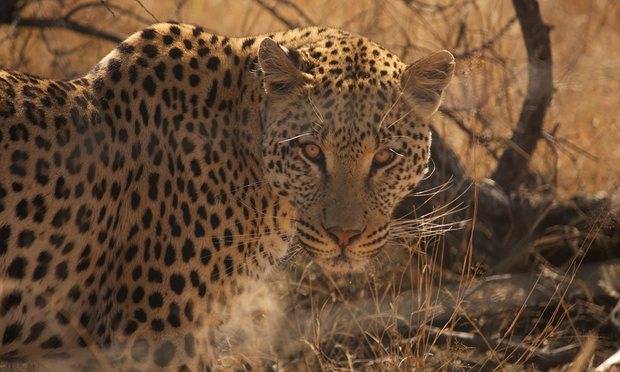
Leopards have lost 75% of their historical habitat
New research shows the big cats’ global range has shrunk by a shocking amount over the last 250 years.
(Photograph: Joseph Lemeris Jr/ZSL)
The area of the world roamed by leopards has declined by three-quarters over the last two and a half centuries, according to the most comprehensive effort yet to map the big cat.
Researchers said they were shocked by the shrinking of the spotted hunter’s range, and that the decline had been far worse for several of the nine subspecies of leopards and in some parts of the world.
“We found the leopard had lost 75% of its historical habitat, we were blown away by that, it was much more than we feared,” said Andrew Jacobson, a conservationist at the Zoological Society of London and lead author of a new study on their range published in the journal PeerJ.
“Our goal has to be to raise consciousness about the plight of the leopard, it’s been flying under the conservation radar for a while. We hoped to raise its profile and say ‘this cat needs your attention’.”
The new work is the first known attempt to draw up a global, historical map of the leopard. Jacobson and researchers found that in 1750 it occupied a vast 35m sq km (13.5m sq mile) area throughout Africa, the Middle East and Asia. But after centuries of habitat loss and hunting caused by humans, that area shrank to just 8.5m sq km.
Leopards in Asia have been particularly badly hit, with six regions losing over 95% of habitat where the species has been, in Jacobson’s view, “almost completely wiped out”.
There appeared to be a clear link between Asia’s economic development and the leopard’s decline there, he said. “South-east Asia and China have been developed for a long period of time and that’s seriously constricted habitat in that area for decades. We worry this will be the trend we will see in Africa in coming decades, as economies grow.”
Even in Africa, the paper found, losses varied greatly, with their range decreasing 99% in North Africa, up to 95% in West Africa but only up to 51% in Southern Africa.
Leopards are a famously reclusive but adaptable species, living nocturnally and hunting a wider variety of prey than other species. They also appear more capable than other big cats at adapting to environments transformed by humans, with leopards living in the outskirts of Mumbai and Johannesburg.
There are no reliable population estimates but it is thought there are over a 100,000 left in Africa and perhaps fewer than 10,000 in Asia.
Jacobson, who is also part of theNational Geographic Society’s Big Cats Initiative, said it was not too late for leopards to bounce back. “I think the leopard can come back. The leopard is an incredibly adaptable animal, we just need to ease off on the hunting pressure, the persecution. They’re cats, they breed pretty well.”
But greater conservation efforts were needed to stop them suffering the dramatic declines seen by some other species, he said. “When people think of endangered animals they think of tigers, elephants, rhino. Thankfully the leopard isn’t in that category yet, and if we are more proactive about them we can stop them being in there.”
The new study – Leopard (Panthera pardus) status, distribution, and the research efforts across its range – examined 6,000 records at 2,500 locations, from over 1,300 sources, including other scientific literature and experts’ data, to draw up a detailed reconstruction of leopards’ range today and in 1750.
(Source : 09-05-2016 The Guardian http://www.theguardian.com/environment/2016/may/ 04/leopards-have-lost-75-percent-of-historical-habitat)

Global Environment Facility IWC In Sri Lanka
The 8th Global Environment Facility (GEF) Biennial International Waters Conference (IWC) will be held in Sri Lanka from May 9 to 13 with representatives from over 80 countries. The week-long conference themed Scaling Up Investments from Source to Sea in the Context of Achieving the SDGs, is jointly organised by the GEF, the Mahaweli Development and Environment Ministry and the United Nations Development Programme (UNDP). IWC held for the first time Sri Lanka, will be graced by President Maithripala Sirisena and the CEO and Chairperson of GEF Dr. Naoko Ishii.
Mahaweli Development and Environment Ministry Secretary Udaya Senevirathne, GEF International Waters Focal Area Environmental Specialist Christian Severin and UNDP Country Director Joern Soerensen joined a briefing to inform the media about the upcoming conference.
Udaya Senevirathne said “safeguarding and managing our water resources remain a priority for the President, who oversees this portfolio and with his guidance, we are keen to partner with GEF and UNDP to host this conference in Sri Lanka for the first time”. He said, “the conference will provide the international practitioners the opportunity to learn about good water management practices, coastal zone management, protected areas and alternative livelihoods in Sri Lanka”.
The conference is expected to bring 250 foreign delegates, including government ministers from Seychelles, Maldives and representatives of GEF beneficiary countries, non-governmental organizations, transboundary waters management institutions, United Nations Agencies, GEF International Waters project managers and staff, and the international private sector. Over 80 countries will be represented at the conference.
UNDP Country Director Joern Soerensen said “With the new global development commitments in mind, IWC organised under the theme Scaling Up Investments from Source to Sea in the Context of Achieving the SDGs will be very important. Especially as it will look at two SDGs—Ensure access to water and sanitation for all and Conserve and sustainably use the oceans, seas and marine resources— with learning tracks devoted to catalysing transformation and scaling up investments; strengthening governance processes to sustain project interventions; and data to policy”.
The GEF Biennial International Waters Conference is the signature learning event for the GEF International Waters portfolio of projects. The IWC objectives are to facilitate cross-sectoral and portfolio-wide learning and experience sharing. Participants sum up progress achieved and also look to the future of programming within and beyond the GEF International Waters focal area.
GEF International Waters Focal Area Environmental Specialist Christian Severin noted, “this 8th IWC will represent about 70 active GEF International Waters projects and will strive to solicit advice from the existing GEF International Waters portfolio on burning issues related to international waters management, and to assist in building participant capacity in key management and technical areas”.
Christian Severin said, “At this conference we are proud to celebrate 25 years anniversary of the GEF and the International Waters Focal Area. With a GEF International Waters portfolio consisting of 242 projects with a portfolio amounting to a total of $10 billion in combined GEF and cofinancing, the GEF International Waters will continue to deliver substantial results and impacts on the local, national and regional level.
The GEF, as the largest financier of cooperation in shared waters systems, occupies a unique space in the International sphere to facilitate countries delivery towards a suite of the SDGs, with a specific focus of SDG 6 and 14”, in the process leading to sustainable management of shared aquifers, lakes, rivers, Large Marine Ecosystems and Open Oceans.
( Source 6 May 2016-Daily News-Sri Lanka)
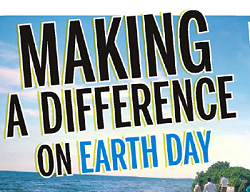
Making A Difference on Earth Day
Ozo Colombo celebrated its commitment for a greener environment by organising a beach-cleaning activity on Marine Drive near the Wellawatte area, commemorating Earth Day.
Over 50 volunteers from Ozo Colombo and members of the Rotaract Club cleaned up more than 300 kilos of garbage – including plastic bottles, bags, slippers, shoes and all non-biodegradable items to provide a foundation of a cleaner, healthier and more sustainable coastal environment for us all.
Abdul Qadir Uvais, the country manager for Earth Hour Sri Lanka also joined the movement.
( Source 6 May 2016-Daily News-Sri Lanka)










